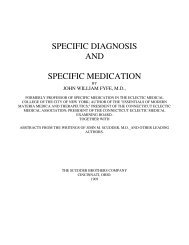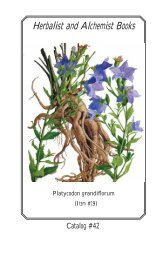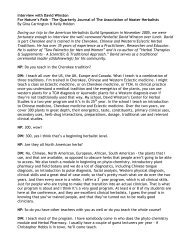MEDlCINAL PLANTS OF JAMAICA. PARTS 1 & 11.
MEDlCINAL PLANTS OF JAMAICA. PARTS 1 & 11.
MEDlCINAL PLANTS OF JAMAICA. PARTS 1 & 11.
You also want an ePaper? Increase the reach of your titles
YUMPU automatically turns print PDFs into web optimized ePapers that Google loves.
PAPAVERACEAE<br />
ARGEMONE MEXICANA L. Mexican Poppy or Thistle.<br />
The use of this species to make tea for colds and fever and perhaps as a general beverage is confirmed. It<br />
is also said to be boiled with chips from Bursera simaruba ("taken from the side of the tree where the sun rises")<br />
to make a drink for high blood pressure. The use of the latex in the treatment of eye com paints appears to be<br />
wide-spread being reported for Mexico. among the Mayas. in French Guiana and in India. It has also been used<br />
in various parts of the world to heal ulcers. to remove warts. as a cure for ringworm and in dropsy and jaundice<br />
cases. The root and shoot decoctions have also been considered diuretic and of use in bladder complaints.<br />
Thomson reported that 1 drachm of the seeds was a dose for worms in adults: the dose was followed by one<br />
composed of 1 tablespoon of spirits of turpentine. 2 tablespoons sweet oil (or aloes) with molasses. (5, 7, 8,<br />
10, 14, 15, 16, l8, 25, 26, 27, 37, 39, 41, 47, 50, 51, 56, 60, 61, 62).<br />
PAPILIONATEAE<br />
ABRUS PRECA TORIUS L. Red Bead Vine.<br />
Commonly called liquorice or wild liquorice the shoots of this species are still used to prepare tea for<br />
colds in Jamaica. The root was at one time included in the Indian Pharmacopoeia. (1, 2, 3, 5, 7, 8, 9, 10, 11, 13,<br />
14, 15, 16, 17, l8, 23, 24, 26, 27, 37, 39, 47, 50, 61, 62).<br />
ANDIRA INERMIS H.B.X. Cabbaqe Bark Tree.<br />
The use of the bark and fruit of this species as a vermifuge is confirmed for Jamaica. In Panama it is used in the<br />
same way and also in Cuba where it is also considered a febrifuge and where a leaf decoction has been used in<br />
the treatment of quick-lime burns. (2, 5, 7, 9, 10, 11, 14, 15, 16, 19, 27, 30, 37, 38, 47, 50, 58, 60, 62).<br />
CAJANUS CAJAN MiIlsp. Gungo Pea; Christmas Pea; Angola Pea; 7 year Pea.<br />
The leaves of this plant boiled with ashes, salt, and the roots of coconut and Zanthoxyllum (prickly<br />
yellows) provide a decoction which is held in the mouth to cure toothache. In Cuba, in addition to the use of<br />
shoots and flowers to prepare pectoral decoctions, poultices are made with the seeds. Lunan reports that Barham<br />
recommends the leaf juice as an eye lotion. Wright considered the leaf decoction useful in uterine haemorrhage<br />
and weakness. (1, 7, 8, 10, 15, 27, 47, 61, 62).<br />
DESMODIUM SPP. Wild Pinder; Puss Gut.<br />
D. AXILLARE DC. Wild Pinder.<br />
D. PROCUMBENS Hitch. Wild Pinder.<br />
D. SUPINUM DC. Wild Pinder; Fever Weed; French Honeysuckle.<br />
D. axillare and D. procumbens are to be included among the Desmodium spp. known as wild pinder and<br />
strong back. The former, used in the usual way for the treatment of back pains, is sometimes used with lresine<br />
paniculata and Borreria laevis to make a drink which is said to "flush out all poison from the kidneys". In Cuba<br />
a root decoction is thought to be of value in the treatment of ulcers and buboes: in Brazil it has been used as a<br />
remedy for acne. D. procumbens like other species makes a tea for back pains and weakness. "<br />
D. supinum is said to be an excellent haemostatic and was used in Cuban hospitals during the wars of<br />
independence: its root decoction is considered to be of some value in the treatment of dysentery. Wright<br />
recorded its use among poor people as a diaphoretic in cases of colds and slight fever: he considered it of no<br />
value.<br />
Desmodium spp. are still used in Jamaica in the treatment of colds: one recipe recommends that it be<br />
boiled with Bidens reptans, Eupatorium odoratum and coconut milk. In Maya medicine the warm crushed plants<br />
were used as a headache poultice. (1, 2, 10, 15, 25, 47, 56, 62).<br />
FLEMINGIA STROBILIFERA R.Br. Wild Hops.<br />
This plant is used in baths for fever patients. Other Flemingia spp. are described as containing resins.<br />
(27).







